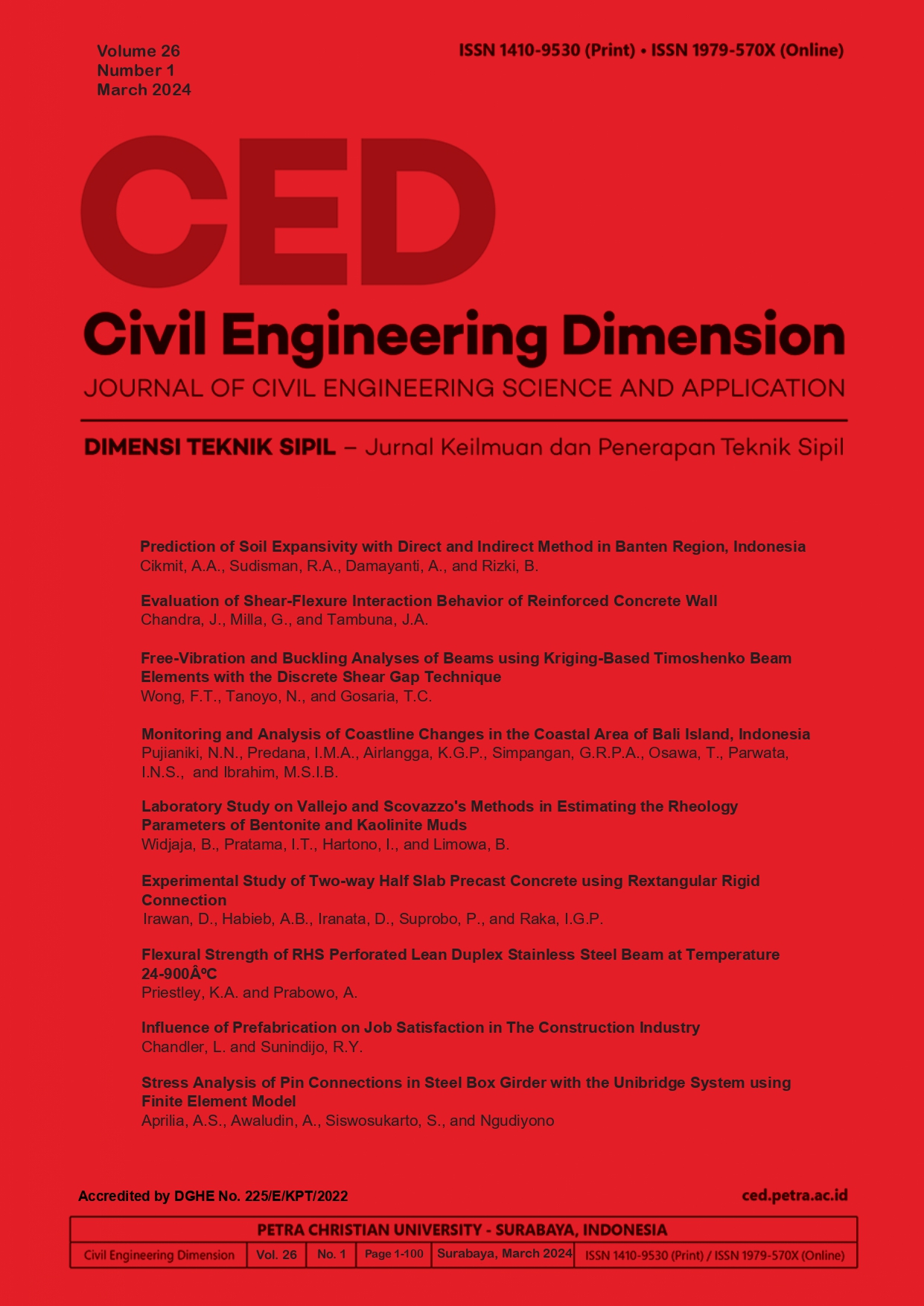Stress Analysis of Pin Connections in Steel Box Girder with the Unibridge System using Finite Element Model
DOI:
https://doi.org/10.9744/ced.26.1.91-100Keywords:
Unibrige, steel box girder, pin connections, finite element, von MisesAbstract
This study analyzes the Unibridge system, a modular steel box girder employing two pins for longitudinal connections, thereby expediting construction compared to traditional girders. A finite element model was developed to analyze the stress on these pins in a single-box girder with five segments and a reinforced concrete floor slab. Various loads were applied following the Indonesian bridge loading standard, SNI 1725:2016. The model considers operational load analysis and assumes full composite behaviour between the top flanges of the girder and the concrete floor slab. The results indicate that the Von-Mises stress on the pins reaches a maximum of 490.95 MPa under combined service loads, consistently remaining below the specified material yield stress limit of 1200 MPa. Consequently, the Demand Capacity Ratio (DCR) is 0.41. As a result, the Unibridge girder connection pins do not experience plastic deformation under the applied loads.
References
Abedi, H.A.O., Rasheed, M.M., and Alwaili, R.A.A., The Effect of Interior Stiffeners on the Flexural Behavior of Concrete-filled Steel Tube Composite Box Girders, Engineering, Technology and Applied Science Research, 13(4), 2023, pp. 11412–11419. DOI: 10.48084/etasr.6088.
Yen, B.T., Strength of Rectangular Composite Box Girders: Recommendations for Design of Composite Box Girders (Final Report), Fritz Laboratory Reports, 1982.
Hassan, E.M. and Mahmoud, H., Analytical and Numerical Behavior of Double Composite Steel Bridges, Journal of Bridge Engineering, 28(1), 2023. DOI: 10.1061/(asce)be.1943-5592.0001972.
Eaethk, J. and Mpaerhtfmg, A., Unibridge®: Construire et Reconsteuire, Eiffage Construction Durable, 2012.
PT Wijaya Karya (Persero) Tbk, Wika Pelindo III Sinergi Bangun Jalur Akses Menuju Terminal Teluk Lamong, Press Release, 2018.
Matiere, N, Ung, Q.H., and Nicolaudie, P.A., Unibridge®: A New Concept in Prefabricated Modular Bridge, Lecture Notes in Civil Engineering, 8, 2018, pp. 981–987. DOI: 10.1007/978-981-10-6713-6_98.
Sukmawijaya, A., Wikon Gandeng Perusahaan Prancis Ekspor Baja Jembatan ke Filipina, April 2019., Retrieved from Kumparan Bisnis: https://kumparan.com/kumparanbisnis/1qwra8Laxxd?utm_source=Desktop &utm_medium=copy-to-clipboard&shareID=4FmNGzGlcIgH, Accessed 18 December 2023.
Badan Standardisasi Nasional, SNI 1725:2016 Pembebanan untuk Jembatan, 2016, [Online]. Available: www.bsn.go.id
Badan Standardisasi Nasional, SNI 1729:2020 Spesifikasi untuk Bangunan Gedung Baja Struktural, 2020.
Coronado, C.A. and Lopez, M.M., Numerical Modeling of Concrete-FRP Debonding Using a Crack Band Approach, Journal of Composites for Construction, 14(1), 2010, pp. 11–21. DOI: 10.1061/(asce)cc.1943-5614. 0000044.
Badan Standardisasi Nasional, SNI 2847:2019 Persyaratan Beton Struktural untuk Bangunan Gedung, 2019.
Dassault Systemes, Getting Started with Abaqus: Keywords Edition, 2014.
Duerr, D., ASME BTH-1 Pinned Connection Design Provisions, 2008. DOI: 10.1061/ASCE1084-0680200813:253.
Li, Y., Huang, R., Zhao, S., and Wang, J., Contact Pressure Analysis of Pin-Loaded Lug with Clearance, Advances in Mechanical Engineering, 14(6), 2022. DOI: 10.1177/16878132221107475.
Conde, J., da Silva, L.S., Tankova, T., Simões, R., and Abecasis, T., Design of Pin Connections Between Steel Members, Journal of Constructional Steel Research, 201, 2023. DOI: 10.1016/j.jcsr.2022.107752.
Logan, D.L., A First Course in the Finite Element Method, 2017.
Beer, F., Mechanics of Materials, Mcgraw-Hill Education, New York, 2009.
American Association of State Highway and Transportation Officials, AASHTO LRFD Bridge Design Specifications, Part I: Sections 1-6, 2017.
Ekvall, J.C., Static Strength Analysis of Pin-Loaded Lugs, Journal of Aircraft, 23(5), 1986, pp. 438–443. DOI: 10.2514/3.45326.
Wearing, J.L., Arnell, P.P, and Patterson, C., A Study of the Stress Distribution in a Lug Loaded by a Free Fitting Pin, Journal of Strain Analysis for Engineering Design, 20(4), 1985, pp. 217–224. DOI: 10.1243/ 03093247V204217.
Lin, S., Hills, D.A., and Nowell, D., Stresses in a Flat Plate due to a Loose Pin Pressing Against a Cracked Hole, Journal of Strain Analysis, 32(2), 2015.
Pedersen, N.L., Stress Concentration and Optimal Design of Pinned Connections, Journal of Strain Analysis for Engineering Design, 54(2), 2019, pp. 95–104. DOI: 10.1177/0309324719842766.
Grant, R.J. and Flipo, B.C.D., Parametric Study of the Elastic Stress Distribution in Pin-Loaded Lugs Modelled in Two and Three Dimensions and Loaded in Tension, Journal of Strain Analysis for Engineering Design, 44(6), 2009, pp. 473–489. DOI: 10.1243/03093247JSA501.
Vičan, J. and Farbák, M., Analysis of High-Strength Steel Pin Connection, Civil and Environmental Engineering, 16(2), 2020, pp. 276–281. DOI: 10.2478/cee-2020-0027.
Bannantine, J., Corner, J.J., and Handrock, J.L., Fundamental of Metal Fatigue Analysis, New Jersey: Prentice Hall, 1989.
American Association of State Highway and Transportation Officials, AASHTO LRFD Bridge Design Specifications, Customary U.S. Units, American Association of State Highway and Transportation Officials, 2012.
Downloads
Published
How to Cite
Issue
Section
License
Copyright (c) 2024 Ayu Sinta Aprilia, Ali Awaludin, Suprapto Siswosukarto, Ngudiyono

This work is licensed under a Creative Commons Attribution 4.0 International License.
Authors who publish with this journal agree to the following terms:- Authors retain the copyright and publishing right, and grant the journal right of first publication with the work simultaneously licensed under a Creative Commons Attribution License that allows others to share the work with an acknowledgement of the work's authorship and initial publication in this journal.
- Authors are able to enter into separate, additional contractual arrangements for the non-exclusive distribution of the journal's published version of the work (e.g., post it to an institutional repository or publish it in a book), with an acknowledgement of its initial publication in this journal.
- Authors are permitted and encouraged to post their work online (e.g., in institutional repositories or on their website) followingthe publication of the article, as it can lead to productive exchanges, as well as earlier and greater citation of published work (See The Effect of Open Access).











